 W
WAll Aboard for Ararat is a 1940 allegorical novella by H. G. Wells that tells a modernized version of the story of Noah and the Flood. Wells was 74 when it was published, and it is the last of his utopian writings.
 W
WAnn Veronica is a New Woman novel by H. G. Wells published in 1909.
 W
WThe Autocracy of Mr. Parham is a novel by H. G. Wells. It was originally published in both Britain and America with illustrations by the British cartoonist Low.
 W
WBealby: A Holiday is a 1915 comic novel by H. G. Wells.
 W
WThe Bulpington of Blup, a 1932 novel by H. G. Wells, is a character study analyzing the psychological sources of resistance to Wellsian ideology, and was influenced by Wells's acquaintance with Carl Gustav Jung and his ideas.
 W
WChristina Alberta's Father (1925) is a novel by H. G. Wells set in London and environs in 1920–1922 with two protagonists: Albert Edward Preemby and his daughter, Christina Alberta.
 W
WThe Croquet Player is a 1936 novella by H. G. Wells, "a sort of ghost story." It has been called "a short allegory written under the stimulus of the Spanish War."
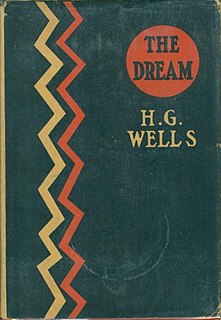 W
WThe Dream is a 1924 novel by H. G. Wells about a man from a Utopian future who dreams the entire life of an Englishman from the Victorian and Edwardian eras, Harry Mortimer Smith. As in other novels of this period, in The Dream Wells represents the present as an "Age of Confusion" from which humanity will be able to emerge with the help of science and common sense.
 W
WThe First Men in the Moon is a scientific romance by the English author H. G. Wells, originally serialised in The Strand Magazine from December 1900 to August 1901 and published in hardcover in 1901, who called it one of his "fantastic stories". The novel tells the story of a journey to the Moon undertaken by the two protagonists: a businessman narrator, Mr. Bedford; and an eccentric scientist, Mr. Cavor. Bedford and Cavor discover that the Moon is inhabited by a sophisticated extraterrestrial civilisation of insect-like creatures they call "Selenites".
 W
WThe Food of the Gods and How It Came to Earth is a science fiction novel by H. G. Wells, first published in 1904. Wells called it "a fantasia on the change of scale in human affairs. . . . I had hit upon [the idea] while working out the possibilities of the near future in a book of speculations called Anticipations (1901)." There have been various B-movie adaptations. The novel is about a group of scientists who invent a food that accelerates the growth of children and turns them into giants when they become adults.
 W
WThe History of Mr. Polly is a 1910 comic novel by H. G. Wells.
 W
WThe Holy Terror is a 1939 work by H. G. Wells that is in part an analysis of fascism and in part a utopian novel.
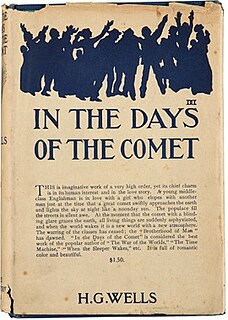 W
WIn the Days of the Comet (1906) is a science fiction novel by H. G. Wells in which humanity is "exalted" when a comet causes "the nitrogen of the air, the old azote," to "change out of itself" and become "a respirable gas, differing indeed from oxygen, but helping and sustaining its action, a bath of strength and healing for nerve and brain." The result: "The great Change has come for evermore, happiness and beauty are our atmosphere, there is peace on earth and good will to all men."
 W
WThe Invisible Man is a science fiction novel by H. G. Wells. Originally serialized in Pearson's Weekly in 1897, it was published as a novel the same year. The Invisible Man to whom the title refers is Griffin, a scientist who has devoted himself to research into optics and who invents a way to change a body's refractive index to that of air so that it neither absorbs nor reflects light. He carries out this procedure on himself and renders himself invisible, but fails in his attempt to reverse it. A practitioner of random and irresponsible violence, Griffin has become an iconic character in horror fiction.
 W
WThe Island of Doctor Moreau is an 1896 science fiction novel by English author H. G. Wells (1866–1946). The text of the novel is the narration of Edward Prendick who is a shipwrecked man rescued by a passing boat. He is left on the island home of Doctor Moreau, a mad scientist who creates human-like hybrid beings from animals via vivisection. The novel deals with a number of philosophical themes, including pain and cruelty, moral responsibility, human identity, and human interference with nature. Wells described it as "an exercise in youthful blasphemy."
 W
WJoan and Peter, a 1918 novel by H. G. Wells, is at once a satirical portrait of late-Victorian and Edwardian England, a critique of the English educational system on the eve of World War I, a study of the impact of that war on English society, and a general reflection on the purposes of education. Wells regarded it as "one of the most ambitious" of his novels.
 W
WLove and Mr Lewisham is a 1900 novel set in the 1880s by H. G. Wells. It was among his first fictional writings outside the science fiction genre. Wells took considerable pains over the manuscript and said that "the writing was an altogether more serious undertaking than I have ever done before." He later included it in a 1933 anthology, Stories of Men and Women in Love.
 W
WMarriage is a 1912 novel by H. G. Wells.
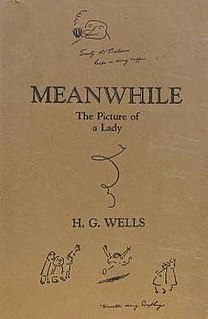 W
WMeanwhile is a 1927 novel by H. G. Wells set in an Italian villa early in 1926. It was chosen as an alternate selection of the recently founded Book of the Month Club and was translated into a number of languages, including Danish, Norwegian, Polish, and Czech. In England, 30,000 copies sold within two months, and by the summer of 1929 50,000 had been sold.
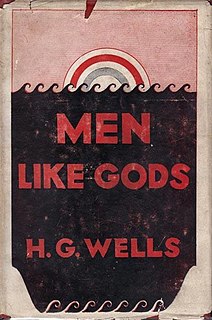 W
WMen Like Gods (1923) is a novel, referred to by the author as a "scientific fantasy", by English writer H. G. Wells. It features a utopia located in a parallel universe.
 W
WMr. Britling Sees It Through is H.G. Wells's "masterpiece of the wartime experience in England." The novel was published in September 1916.
 W
WMr. Blettsworthy on Rampole Island is a 1928 novel by H. G. Wells.
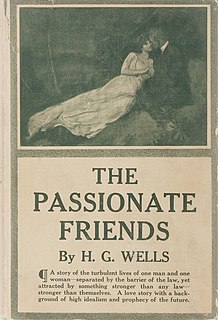 W
WThe Passionate Friends is a 1913 novel by H. G. Wells.
 W
WThe Research Magnificent is a 1915 novel by H. G. Wells.
 W
WThe Sea Lady is a fantasy novel by British writer H. G. Wells, including some of the aspects of a fable. It was serialized from July to December 1901 in Pearson's Magazine before being published as a volume by Methuen. The inspiration for the novel was Wells's glimpse of May Nisbet, the daughter of the Times drama critic, in a bathing suit, when she came to visit at Sandgate, Wells having agreed to pay her school fees after her father's death.
 W
WThe Shape of Things to Come is a work of science fiction by British writer H. G. Wells, published in 1933, which speculates on future events up to the year 2106.
 W
WThe Sleeper Awakes is a dystopian science fiction novel by English writer H. G. Wells, about a man who sleeps for two hundred and three years, waking up in a completely transformed London in which he has become the richest man in the world. The main character awakes to see his dreams realised, and the future revealed to him in all its horrors and malformities.
 W
WBrynhild, or The Show of Things is a 1937 novel by H. G. Wells.
 W
WThe Soul of a Bishop is a 1917 novel by H. G. Wells.
 W
WStar Begotten is a 1937 novel by H. G. Wells. It tells the story of a series of men who conjecture upon the possibility of the human race being altered, by genetic modification, by Martians to replace their own dying planet.
 W
WThe Time Machine is a science fiction novella by H. G. Wells, published in 1895 and written as a frame narrative. The work is generally credited with the popularization of the concept of time travel by using a vehicle or device to travel purposely and selectively forward or backward through time. The term "time machine", coined by Wells, is now almost universally used to refer to such a vehicle or device.
 W
WTono-Bungay is a realist semiautobiographical novel written by H. G. Wells and first published in book form in 1909. It has been called "arguably his most artistic book". It had been serialised before book publication, both in the United States, in The Popular Magazine, beginning in the issue of September 1908, and in Britain, in The English Review, beginning in the magazine's first issue in December 1908.
 W
WThe Undying Fire, a 1919 novel by H. G. Wells, is a modern retelling of the story of Job. Like the Book of Job, it consists of a prologue in heaven, an exchange of speeches with four visitors, a dialogue between the protagonist and God, and an epilogue in which the protagonist's fortunes are restored. The novel is dedicated "to All Schoolmasters and Schoolmistresses and every Teacher in the World."
 W
WThe War in the Air: And Particularly How Mr. Bert Smallways Fared While It Lasted, a military science fiction novel by H. G. Wells, written in four months in 1907 and serialised and published in 1908 in The Pall Mall Magazine, is like many of Wells's works notable for its prophetic ideas, images, and concepts—in this case, the use of the aircraft for the purpose of warfare and the coming of World War I. The novel's hero is Bert Smallways, a "forward-thinking young man" and a "kind of bicycle engineer of the let's-'ave-a-look-at-it and enamel-chipping variety."
 W
WThe War of the Worlds is a science fiction novel by English author H. G. Wells, first serialised in 1897 by Pearson's Magazine in the UK and by Cosmopolitan magazine in the US. The novel's first appearance in hardcover was in 1898 from publisher William Heinemann of London. Written between 1895 and 1897, it is one of the earliest stories to detail a conflict between mankind and an extraterrestrial race. The novel is the first-person narrative of both an unnamed protagonist in Surrey and of his younger brother in London as southern England is invaded by Martians. The novel is one of the most commented-on works in the science fiction canon.
 W
WThe Wheels of Chance is an early comic novel by H. G. Wells about an August 1895 cycling holiday, somewhat in the style of Three Men in a Boat. In 1922 it was adapted into a silent film The Wheels of Chance directed by Harold M. Shaw.
 W
WThe Wonderful Visit is an 1895 novel by H. G. Wells. With an angel—a creature of fantasy unlike a religious angel—as protagonist and taking place in contemporary England, the book could be classified as contemporary fantasy, although the genre was not recognised in Wells's time. The Wonderful Visit also has strong satirical themes, gently mocking customs and institutions of Victorian England as well as idealistic rebellion itself.
 W
WThe World of William Clissold is a 1926 novel by H. G. Wells published initially in three volumes. The first volume was published in September to coincide with Wells's sixtieth birthday, and the second and third volumes followed at monthly intervals.
 W
WThe World Set Free is a novel written in 1913 and published in 1914 by H. G. Wells. The book is based on a prediction of a more destructive and uncontrollable sort of weapon than the world has yet seen. It had appeared first in serialised form with a different ending as A Prophetic Trilogy, consisting of three books: A Trap to Catch the Sun, The Last War in the World and The World Set Free.